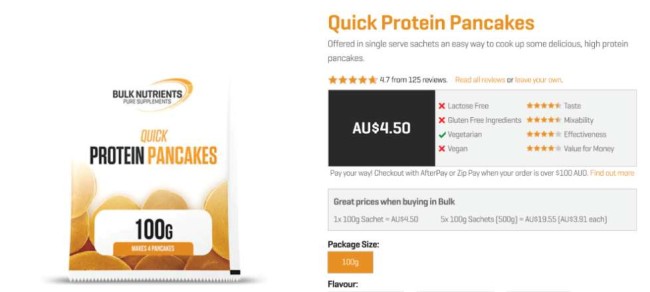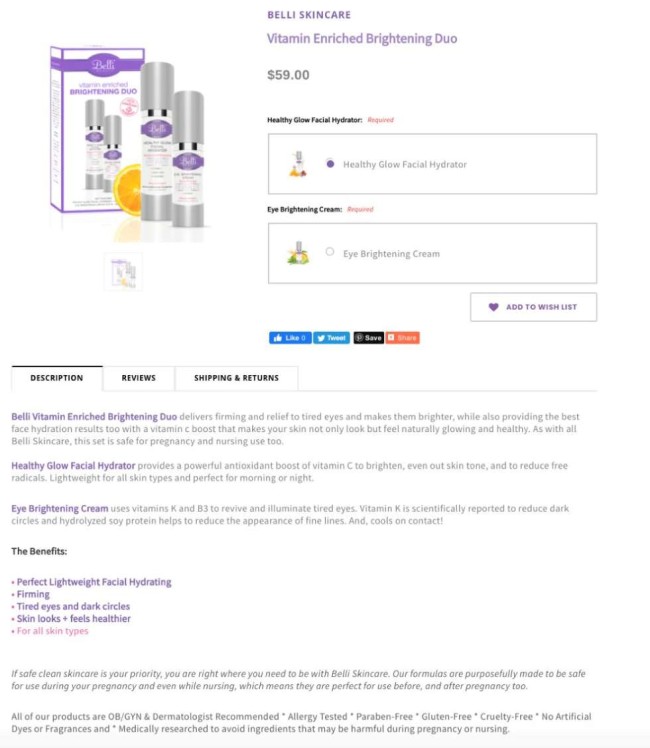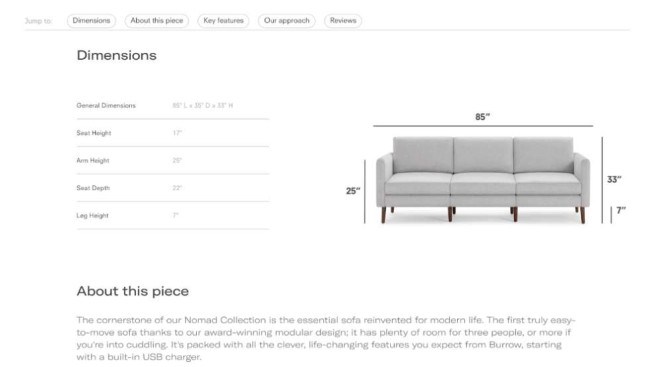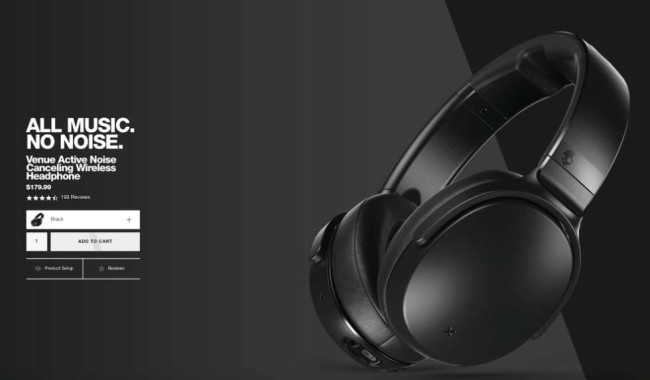Here's an undeniable fact: If you want to do well in eCommerce, you need to create great product pages. They're arguably the most important part of the whole online retail shebang.
Good product pages increase your conversion rate. Bad product pages block up your sales funnel. It's as simple as that.
Sure, the stakes are high, but don't let that put you off. In this article, we'll talk about the essential parts of a product page. Then, we'll teach you how to craft a perfect product page of your own. The best part? You'll enjoy yourself.
Table of Contents
The Essential Parts Of A Product Page
Well-constructed product pages are like sponge cakes: They look good; they go down well, and they leave you wanting more. They also have four main ingredients:
- Product name (butter): Smooth as the alias suggests, great product names are simple, memorable, and easy to digest.
- Product image (sugar): Like sweetener, compelling images add flavor and make your product more desirable.
- Product description (flour): Thoughtfully written content is king — and like flour in a cake, it is the bulk component in your page.
- User experience (egg): Eggs are one of the leavening ingredients which cause a cake to rise. A thoughtfully crafted user experience gives your page a similar lift.
You may be thinking "Hey — what about vanilla essence and baking powder? What about the all-important pinch of salt?" Well, those are the creative skills you'll use to bring your page together. We'll come back to those later on.

Why Product Pages Are Important For Your Store's Growth
Consumers can't physically interact with the merchandise in eCommerce stores — and that's where well-conceived product pages come in. All sorts of things — from Bluetooth speakers to water bottles — sell in greater numbers when they feel real to the customer.
Let's dive into that a little more:
1. Great Product Pages Help Optimize Your Website
Excellent product pages are an essential part of SEO. If you don't optimize your page, people won't be able to find your merchandise. If you do optimize your product pages, they'll collectively help optimize your entire site.
A lot of reverse engineering goes into SEO.
To achieve a good Google rank, you need to figure out which terms consumers search for when they look for products like the ones you sell. Then, you have to include those keywords in the content on your page.
Business intelligence tools and tools like Google Analytics can help you find relevant keywords, while platforms like INK make SEO-centric writing easier. Alternatively, you can also hire one of the top SEO agencies to help you with all this.
2. Great Product Pages Increase Conversions
Remember that sales funnel we mentioned earlier? Your product pages sit at the bottom of that funnel, where they either convert visitors to customers or put them off your site completely.
Perhaps unsurprisingly, well-designed product pages work in your favor at this stage in the game.
Consumers who reach the product pages on your site are already interested in your product and open to suggestions. All you need to do is give them a gentle nudge.
To get a sale, you simply have to convince visitors that your item provides relatable value.
That’s why many e-commerce business owners decide to go with eCommerce development companies in order to get the best results.
What Makes A Perfect Product Page?
- Large, Beautiful Images
- Unique Product Descriptions
- Add Reviews And Ratings
- Clear Calls To Action
- Product Recommendations
You don't need a degree in communication to create an effective product page. All you have to do is follow a set of best practices. Here are five essential things to include whenever you publish a new product page:
1. Large, Beautiful Images
As we mentioned earlier, consumers expect to see impressive product images — and plenty of them.
The Salsify survey we drew upon at the beginning of this article went further than a general consensus by separating consumers into age groups.
Consumers aged 18 to 24 wanted to see eight images and four videos per product. Consumers in the 35 to 44 age range agreed with the image quota but expected five videos instead of four.
By the way, if you're interested in exploring this avenue, we have a list of the top video production companies here.
Back to the point:
Further research by Hubspot shows that product pages stocked with high-quality images get 94% more views.
Clearly visual merchandising is vital — even in a virtual environment. Here are a few hot tips to help you create revenue-boosting product pics:
- Use high-resolution images: When consumers can't physically handle products, high-res images make them feel real. Think about the aspects of each product you'd want to examine in a store and provide closeups accordingly. If your image background is too distracting, you can change background of photo to make the image visually pleasing.
- Use large images: Never skimp on pixel dimensions. People want to be able to zoom in to peer at your product, so avoid using photos smaller than 1024x1024 pixels.
- Optimize your images for the web: Pixel dimensions and file sizes are not the same things. For best results, use a good photo editing software like PhotoShop and save your images as optimized JPGs to cut down on page load time.
- Leverage customer images: Use your existing fan base to drive sales by encouraging people to post images of themselves using your product. Social proof helps build brand credibility.
Insider Advice #1: Sometimes, PNGs are better than JPGs. PNG files support transparent backgrounds, so they're great for logos, computer-generated images, and product pics displayed over a digital background. PNGs also support a wider color range and have a better contrast ratio than JPGs, so they're ideal for highly detailed product images.
PNGs also support a wider color range and have a better contrast ratio than JPGs, so they're ideal for highly detailed product images.There are also many tools, such as a background removal tool, that can be used to remove the unwanted background from your pictures.

2. Unique Product Descriptions
Don't be tempted to recycle or amend product descriptions. Duplicate content thins your online presence and nullifies your SEO strategy. Instead, create a brand new description for each product.
As you write, think about what the product is for, who it's for, how it works, and why it's different from similar products available elsewhere. You need to convince visitors to buy your product on the spot. Here's how:
Tip #1: Write for your target audience
Think about who you're trying to sell your product to. If this isn't something you've considered before, create a buyer persona and then target your text at your imaginary customer.
Tip #2: Use action words
Action words encourage… action! Begin each description with an action word to tell readers what they can achieve with your product. Like so:
- "Decorate your living room with this multi-tonal wallpaper."
- "Make supper simple with our range of family-friendly ready meals."
- "Chop vegetables in seconds with this space-saving mini food processor."
Tp #3: Use the language your customers use
Selling a range of tools? Use a practical tone and straightforward language. Selling expensive antiques? Use formal language and appropriate terms to show your expertise.
3. Add Reviews And Ratings
Reviews — especially when they include customer images — make your brand more credible. According to Bazaarvoice's Conversion Index Volume 8, visitors who look at reviews are 58% more likely to make purchases.
Let's revisit social proof.
You probably read reviews the last time you bought something new, too. The product review premise is simple: If existing customers think a product or service is great, you'll probably have a similarly positive experience.
40% of customers will commence doing business with a competing brand that has a reputation for good customer service. In a nutshell, that's social proof.
If your brand wins an award, mention it on your product page. Trust badges (Better Business Bureau accreditation, TRUSTe certification) reassure consumers — especially if your brand is new on the market.
4. Clear Calls To Action
Site visitors often need to be told what to do next. A well-written call to action (CTA) at the end of your product description acts as a prompt.
Inbound marketing experts call CTAs a "secret weapon" because they increase conversions, boost AOV, and generally funnel leads to the finish line.
Need a few CTA examples? Here you go:
- "Click here to find out more about our energy-boosting bio supplement and get 10% off your next order."
- "Buy today and get overnight shipping for free!"
- "Contact us right now to arrange a free consultation or a personal product demonstration."
CTA hacks go beyond text and may include:
- An arrow button: Adding an arrow icon to your CTA can increase click-through rate (CTR) by 26%.
- Red or orange text: Changing the color of your text from boring black to vibrant red or orange can boost your conversion rate by as much as 32.5%.
- A clickable button: Turning your entire CTA into a giant button could enhance CTR by 45%.
- Reduced clutter: Showcase your CTA in a minimalist setting and gain up to 232% more click-through traffic.
- Personalization: Targeted CTAs can increase your CTR by as much as 42%.
Insider Advice #2: CTAs are a magic marketing strategy ingredient, too. According to surveys by AdRoll and Wordstream, CTAs improve click-through rates on social media posts by 285% and boost CTR on marketing emails by 371%.
5. Product Recommendations
Product recommendations — personalized or not — can drive your average basket value skyward. Just find yourself a good Wordpress popup plugin and you'll be able to create great popups without having to learn to code. Plugins like Popup Anything enable ecommerce businesses to target specific visitors and turn them into buyers, returning customers, and email subscribers.
Put a few under your product description to enhance your page and create a general buzz around your brand. There are eight main types of product recommendations:
- Similar products: Similar product suggestions make it easy for consumers to find their ideal merchandise match.
- Upsell options: Show off higher-priced premium versions of a product to encourage consumer spending.
- Frequently bought together: Line up products that go with one another to double your AOV.
- Recommended products: Use data to recommend products based on a visitor's browsing history.
- Previously viewed: Show visitors products they've previously viewed to encourage a purchase.
- Product bundles: Make it easy for customers to buy bundles by offering them a special discount.
- Trending products: Use peer pressure to encourage visitors to choose additional items.
- New arrivals: Showcase seasonal collections and brand new tech items with a new arrivals carousel.

5 eCommerce Product Pages For Inspiration
Emulation is a sure-fire formula for success. Let's look at some of the most effective product pages we've seen lately and talk about why they work so well:
1. Larq
Larq is basically a single-product company. Innovative self-cleaning water bottles in various colors and accompanying sleeves make up the majority of its online offerings.
Its main water bottle page is simple and elegant, and it explains what the Larq water bottle offers and how it's different from other water bottles.
Looking at the language, the science, and the price point on Larq's product page, we can see that Larq's target consumer base is both tech-savvy and reasonably affluent.
Minimalist and easy to absorb, Larq's product page provides a sophisticated, intuitive experience.

2. Burrow
Next let's look at the Block Nomad sofa from Burrow. Burrow makes premium-quality furniture to order and ships each piece directly from the manufacturer to the consumer.
The Nomad is a no muss, no fuss three-seater, and it has a stain-resistant finish — luxe and longevity in one convenient package.
Product selection and checkout is a notorious barrier to purchase, but Burrow makes it easy. Radio buttons let you select color, finish, arm style, cushion choice, and optional upgrades.
Every time you switch from one option to another, the main image changes to match. It's easy to envision the sofa you'll receive — and that's a genius marketing move. Bravo, Burrow.
Scrolling down, the Block Nomad product page is polished and uncontrived. Dimensions come first, and then we move on to a brief, thoughtful product description.
Key features follow (icons create a visual marker) and then a quote from the Burrow CEO, which creates a clever connection between the company and the consumer. Auto-play videos and animations act as a garnish.


3. Revelry
Time for a little timeless garb. Founded in 2009, Revelry sidesteps traditional retail and makes it easy to shop for bridesmaid dresses at home.
You can order fabric swatches, choose dress length, and specify custom extras without leaving your living room. Every dress is made to order in a wide range of sizes, colors, and materials.
For the sake of this breakdown, let's examine the Dylan velvet bridesmaid dress product page.
Right under the product name we have the price, listed in full and also in Klarna installments. Installment pricing can help you increase sales by spreading the cost of expensive items, making them more immediately affordable.
Good move, Revelry.
Consumers can select options like color, size, dress length, and delivery time via convenient, intuitive drop-down lists and radio buttons.
Moving down the page, we see a product description and more information about the dress. Finally, reviews provide social proof and a "More to Love" carousel suggests alternatives.

4. Skullcandy
Music is a universal language and Skullcandy products make it easier to experience.
Take the brand's Venue noise-canceling headphones, for example.
Comfortable and carefully designed, they also include active noise-canceling technology to make harmonies easier to hear. We learn this information almost immediately because it's so clearly displayed on the product page.
Bright colors and cutting-edge graphics give this page a hip ambiance; easy-to-understand icons and single-sentence summary descriptions provide readers with snackable, scannable information.
Later on, a video shows the product off from all angles, turning it from a two-dimensional into a three-dimensional item. Scroll down a bit more and you get full-screen features and benefits.
Photographs, quotes, and tech facts promote Venue headphones as a viable (and trendier) alternative to a better-known noise-canceling brand. Reviews sit at the bottom of the page in centered format — and they look like album ratings.
Clever, and right on par with the record company vibe. Well played, Skullcandy.


5. Apple
Apple's product pages are characterized by their simple and elegant design. The use of white space, minimalistic typography, and a consistent layout allows the product to take center stage.
Their large, high-resolution images showcase the product from different angles, highlighting the product's design, materials, and craftsmanship.
Taking things a step further, Apple uses interactive elements to engage users. For example, users can rotate and zoom in on product images to get a closer look at details. This interactive approach enhances user experience and provides a sense of control.
Another winning element of the overall design are the product descriptions which are brief, yet impactful. The product page highlights the standout features of the product, often accompanied by short videos that demonstrate how these features work in real life.
When applicable, Apple also showcases customization options, such as color choices and storage capacities. This helps customers tailor the product to their preferences.
The product page features a clear and prominent, blue, CTA button that directs users to make a purchase. This CTA stands out against the minimalist design and guides users toward conversion.
Apple's product pages are designed to be responsive, ensuring a consistent and user-friendly experience across different devices, including desktops, tablets, and smartphones.
Overall, Apple's product pages prioritize simplicity, clarity, and a focus on the product's value proposition. They effectively combine visual appeal with informative content to create a compelling user experience that encourages conversions.
eCommerce Product Pages Takeaways
Product pages sit near the bottom of your sales funnel, where they either compel visitors to make purchases or cause them to bounce right out of your site.
Great product pages include well-written and unique descriptive text, compelling images, genuine reviews, and a clear call to action.
Add a little flair of your own to all those page elements, and you'll bring your products to life. Don’t be alarmed if you see a spike in sales after optimizing your product pages! Good luck!
eCommerce Product Pages FAQs
1. What is a product page in eCommerce?
A product page in eCommerce is a webpage dedicated to providing detailed information about a specific item available for purchase online. It includes product images, descriptions, pricing, and a way to add the item to the shopping cart, aiming to inform and persuade potential buyers to make a purchase.
2. How do I create a product page for my eCommerce website?
To create a product page for your eCommerce website, you should:
- Select an eCommerce platform like Shopify, WooCommerce, or Magento to build your website and product pages
- Gather high-quality images, a clear product title, a detailed description, pricing, and any variations (e.g., sizes, colors)
- Design a clean and organized layout with a focus on visuals
- Write a concise yet informative product description highlighting features, benefits, and uniqueness
- Display the product's price, any discounts, and shipping costs transparently
- Include a clear CTA button for easy purchasing
- If applicable, provide options for customers to select different sizes, colors, or other variations
- Integrate customer reviews and ratings for social proof and credibility
- Communicate shipping details, estimated delivery times, and your return policy
- Ensure your product page is responsive and looks good on mobile devices
- Use relevant keywords in your title, description, and meta tags to improve search engine visibility
- Display trust badges, security icons, and payment options to reassure customers
- Suggest complementary items to encourage upsells









